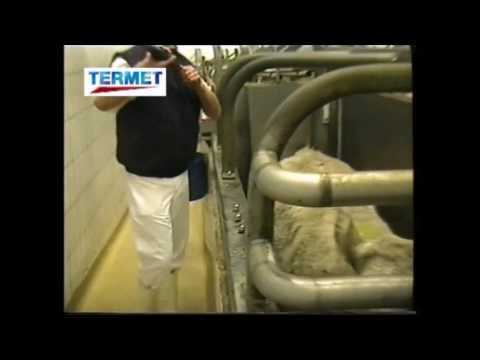The humane treatment of animals is crucial to livestock management and meat production. Ethical considerations, coupled with stringent regulations, have driven the development of advanced tools and technologies designed to ensure livestock welfare. One such innovation is the Termet Matador stunning equipment, a leading solution in humane livestock tools.
This article explores how Termet Matador stunning equipment is revolutionising abattoir stunning technology, promoting ethical slaughtering practices, and enhancing humane slaughter in Australia.
We also cover the changes the Australian Government has implemented over the years to enhance the humane treatment of livestock, so let’s get going!
The Importance of Humane Livestock Treatment
Humane livestock treatment is not just a moral obligation but also a legal requirement in many countries, including Australia.
The welfare of animals in abattoirs is governed by strict regulations to ensure that they are treated with respect and care throughout the slaughtering process.
Humane treatment minimises stress and pain for the animals, which is crucial for both ethical and practical reasons. Stress and pain can negatively impact the quality of meat, making humane practices beneficial for both the animals and the industry.
Termet Matador Stunning Equipment: A Game Changer
Termet Matador stunning equipment is at the forefront of humane livestock tools, offering a range of features designed to ensure effective and humane stunning.
The equipment is engineered to deliver a quick and painless stun, rendering the animal unconscious instantly. This is achieved through the use of a captive bolt mechanism, which is both reliable and efficient.
Key Features of Termet Matador Stunning Equipment:
- Captive Bolt Mechanism: The Termet Matador stunning equipment utilises a captive bolt mechanism, which is widely regarded as one of the most humane methods of stunning. The bolt is driven into the animal’s brain, causing immediate unconsciousness without pain.
- Safety and Reliability: Safety is a top priority in the design of Termet Matador stunning equipment. The equipment features a safety locking system to prevent accidental discharge, ensuring the safety of the operator. Additionally, the equipment is made from durable materials, guaranteeing long-term reliability and consistent performance.
- Versatility: Termet Matador stunning equipment is suitable for a variety of livestock, including cattle, pigs, sheep, and goats. This versatility makes it an ideal choice for abattoirs that process multiple species.
- Ease of Use: The equipment is designed for ease of use, with an ergonomic design that reduces operator fatigue. The simple loading and firing mechanism ensures that the stunning process is quick and efficient.
Ethical Slaughtering Tools and Technology
The development of ethical slaughtering tools and technology is driven by the need to balance efficiency with animal welfare.
Termet Matador stunning equipment exemplifies this balance, providing a solution that meets the highest standards of humane treatment while also being practical for abattoir operations.
Benefits of Ethical Slaughtering Tools:
- Improved Animal Welfare: Ethical slaughtering tools like the Termet Matador stunning equipment ensure that animals are treated with the utmost care and respect. By minimising pain and stress, these tools contribute to better overall animal welfare.
- Compliance with Regulations: Abattoirs must comply with strict regulations regarding animal welfare. Using advanced stunning equipment helps abattoirs meet these requirements, avoiding legal issues and potential fines.
- Enhanced Meat Quality: Stress and pain can negatively impact the quality of meat. By ensuring a quick and painless stun, ethical slaughtering tools help maintain the quality of the meat, benefiting both producers and consumers.
- Positive Public Perception: Consumers are increasingly concerned about the ethical treatment of animals. Abattoirs that use humane stunning equipment can promote their commitment to animal welfare, enhancing their reputation and attracting ethically-minded customers.
Humane Slaughter in Australia
Australia has some of the strictest animal welfare regulations in the world, particularly concerning the humane treatment of livestock in abattoirs.
The use of advanced stunning equipment, such as the Termet Matador, is essential for compliance with these regulations and for promoting humane slaughter practices.
Key Aspects of Humane Slaughter in Australia:
- Regulatory Framework: The Australian government has established comprehensive guidelines for the humane treatment of livestock. These guidelines cover all aspects of the slaughtering process, from handling and transport to stunning and killing.
- Industry Standards: In addition to government regulations, industry standards also play a crucial role in promoting humane slaughter. Organisations such as the Australian Meat Industry Council (AMIC) provide guidelines and support to abattoirs to ensure best practices are followed.
- Training and Education: Proper training and education are vital for ensuring that abattoir staff are knowledgeable about humane slaughter practices. Many abattoirs invest in training programs to ensure their staff are skilled in using advanced stunning equipment and adhering to animal welfare standards.
- Continuous Improvement: The commitment to humane slaughter in Australia is an ongoing process. Abattoirs continually seek to improve their practices and adopt new technologies to enhance animal welfare.
Abattoir Stunning Equipment in Australia
The adoption of advanced abattoir stunning equipment in Australia is a testament to the industry’s commitment to humane treatment. Termet Matador stunning equipment is widely used across the country, providing abattoirs with a reliable and effective solution for humane stunning.
Choosing the Right Equipment:
- Assessing Needs: Abattoirs must assess their specific needs when choosing stunning equipment. Factors such as the types of livestock processed, the volume of animals, and regulatory requirements must be considered.
- Quality and Reliability: The quality and reliability of the equipment are paramount. Termet Matador stunning equipment is known for its durability and consistent performance, making it a trusted choice for abattoirs.
- Support and Maintenance: Ongoing support and maintenance are essential for ensuring the equipment remains in optimal condition. Abattoirs should choose suppliers that offer comprehensive support services, including training, maintenance, and repairs.
OVERVIEW
The use of Termet Matador’s stunning equipment represents a significant advancement in humane livestock treatment. By combining cutting-edge technology with a commitment to animal welfare, this equipment ensures that the stunning process is both effective and humane.
For abattoirs in Australia, adopting such advanced stunning tools is not only a regulatory requirement but also a moral imperative.
By prioritising humane treatment, the industry can continue to improve animal welfare standards and meet the growing demand for ethically produced meat.
The Australian Government’s Commitment to Humane Livestock Treatment
The Australian Government has taken significant steps over the years to improve the humane treatment of livestock. These measures are designed to ensure that animals are treated with respect and care throughout their lives, particularly during transport and slaughter.
Here are some key initiatives and regulations that have been implemented:
National Animal Welfare Standards and Guidelines
The Australian Government, in collaboration with state and territory governments, has developed the Australian Animal Welfare Standards and Guidelines. These standards provide a consistent framework for the humane treatment of livestock across the country. They cover various aspects of animal welfare, including housing, handling, transport, and slaughter. The guidelines are regularly updated to reflect the latest scientific research and best practices in animal welfare.
Model Codes of Practice
Before the development of the national standards, the Model Codes of Practice for the Welfare of Animals were used. These codes provided detailed guidelines on the care and management of different species of livestock.
While they have been largely replaced by national standards, they laid the groundwork for the current regulatory framework and continue to influence animal welfare practices.
Animal Welfare Task Group
The Animal Welfare Task Group (AWTG) is a multi-jurisdictional body that oversees the development and implementation of animal welfare standards and guidelines.
The AWTG ensures that the standards are based on scientific evidence and stakeholder consultation, providing a balanced approach to animal welfare.
Legislation and Enforcement
Each state and territory in Australia has its own legislation governing animal welfare, which is enforced by various government agencies. These laws set out the minimum standards for the treatment of livestock and provide penalties for non-compliance.
The legislation is designed to protect animals from cruelty and ensure their welfare throughout their lives.
Training and Education
Proper training and education are crucial for ensuring that livestock handlers and abattoir workers understand and implement humane practices. The government supports various training programs and resources to educate those involved in the livestock industry.
This includes courses on low-stress handling techniques, pain relief methods, and the use of humane stunning equipment.
Animalplan 2022 to 2027
Animalplan 2022 to 2027 is Australia’s first national action plan for the production of animal health. It consolidates themes from over 30 existing strategies and frameworks, focusing on improving animal welfare outcomes, enhancing biosecurity practices, and managing the risk of antimicrobial resistance.
The plan was developed through extensive stakeholder engagement and is endorsed by both federal and state governments.
Industry Initiatives
In addition to government measures, the livestock industry in Australia has also taken steps to improve animal welfare.
Industry bodies such as the Australian Meat Industry Council (AMIC) and the National Farmers’ Federation (NFF) work closely with the government to develop and promote best practices.
These organisations provide resources and support to farmers and abattoirs, helping them to comply with welfare standards and improve their practices.
SUMMARY
The Australian Government has implemented a comprehensive framework to improve humane slaughter in Australia. Through national standards and guidelines, legislation, research, training, and industry collaboration, significant progress has been made in ensuring the welfare of animals.
These efforts reflect a commitment to ethical practices and the recognition of the importance of animal welfare in the livestock industry. As advancements continue, abattoir stunning equipment in Australia remains at the forefront of promoting humane treatment for livestock, benefiting both the animals and the industry as a whole.





